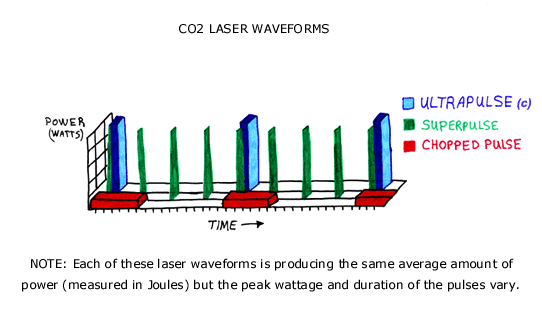|

Laser energy (like electrical energy) can be applied to tissues to produce a wide variety of surgical effects. Laser energy (photons) can be emitted from one of several different lasing substances, with each substance having a unique (atomic) structure that largely determines the wavelength and frequency of the emitted photons (energy).
The wavelength of the emitted photons (laser energy) determines several important characteristics of the laser, such as its absorption by different types of tissue, the relative ability to pass through fluids, and the cutting and coagulating effects. Carbon dioxide (CO2) lasers are infrared, absorbed by all tissues and fluids, cannot pass through fluids, are excellent at cutting and are poor at coagulating. Potassium titanyl phosphate (KTP) laser energy is green in color, penetrates pigmented tissue poorly but unpigmented tissue deeply, passes through fluids, and is good for cutting and coagulating.
CO2 lasers are ideal for infertility work since they do not penetrate tissues deeply. The CO2 laser energy is absorbed by the target tissue (all tissues are predominantly composed of water), the intracellular water is boiled (vaporized), and the (tissue) cells “explode.” The CO2 laser energy is not able to pass through (any) fluids so the overall depth of penetration with this laser is extremely small (as compared to any other laser used in gynecologic work).
The tissue effect of the applied laser energy is also dependent on the power density and the laser waveform that is used. Laser waveform choices include continuous mode (continuous laser energy is delivered for as long as the control foot pedal remains depressed), pulsed mode (single or repeated pulses of predetermined duration and frequency that are delivered when the control foot pedal is depressed), superpulse mode (repeated very short duration pulses of very high peak power), and Ultrapulse® mode (repeated short duration pulses of very high peak power with extraordinarily high power density per pulse).
Continuous mode CO2 laser generally delivers low power for (relatively) long periods of time, which means that the tissue surrounding the target tissue can be heated significantly. Therefore, although the depth of penetration is small there can be a diffuse heating of surrounding tissue with subsequent burn injury. Repeated (chopped) pulse waveform also generally delivers low power for long periods of time (compared to either superpulse or Ultrapulse®), which has the ability to heat surrounding tissue and cause inadvertant (burn) injury. Superpulse mode delivers up to 10 times greater peak power than continuous mode and 4-5 times greater peak power than repeated (chopped) pulse for the same average power output per unit time. Therefore, with superpulse mode there is a longer refractory (off) period between the bursts of energy, which allows for dissipation of heat (so that it cannot build up) and dramatically reduces the chance for thermal (burn) injury. With superpulse mode, as compared to continuous or repeated pulse modes, there is also less tissue dessication (dehydration or drying), carbonization (char buildup), thermal (burn) injury, and smoke plume so that the surgeon can produce clean (char free) tissue vaporization with minimal lateral thermal damage at a controlled rate of power delivery. The Ultrapulse® mode delivers the highest power density available (compared to the other waveforms reviewed here), has a peak power similar to superpulse but maintains this output for a much longer duration per pulse (compared to superpulse), and has the longest refractory (off) period between bursts of energy (4-5 superpulse bursts are required to match the Ultrapulse® power output per unit time). Therefore, Ultrapulse® mode is associated with the least amount of tissue dessication, carbonization, and potential for lateral thermal injury to the surrounding tissue. My preference for all laparoscopic infertility work is the CO2 laser using Ultrapulse® power settings.
®UltraPulse is a registered trademark of Lumenis Inc
|

|